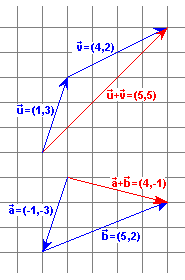|
ACTIVITY 2.2 |
|||
| The vector sum is a very easy operation of acting when we work with components: adding the two components, the 1rst with the 1rst and the 2nd with the 2nd is enough. So, in the figure you have next sums made:
In general, if
|
 |
|
INTERACTIVE ACTIVITY You have two vectors Make graphically the following sums of vectors with given by his components:
You observe that always it's verified : |
| HOMEWORK |
Make the following sums of vectors representing them in a squared paper:
a) (-2, 4) + (5, 2) d) (-3, 3) + (-3, 3) |
b) (1, -3) + (-7, 4) e) (4, 5) + (-4, 1) |
c) (-4,0) + (7, -6) f) (3, -5) + (-3, 5) |
|
END OF ACTIVITY 2.2 |
|||